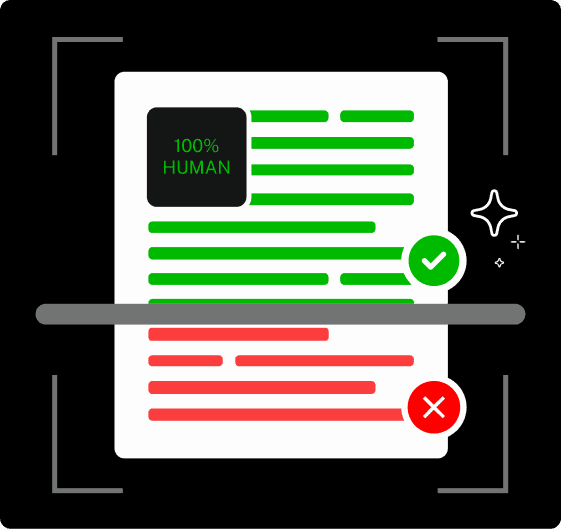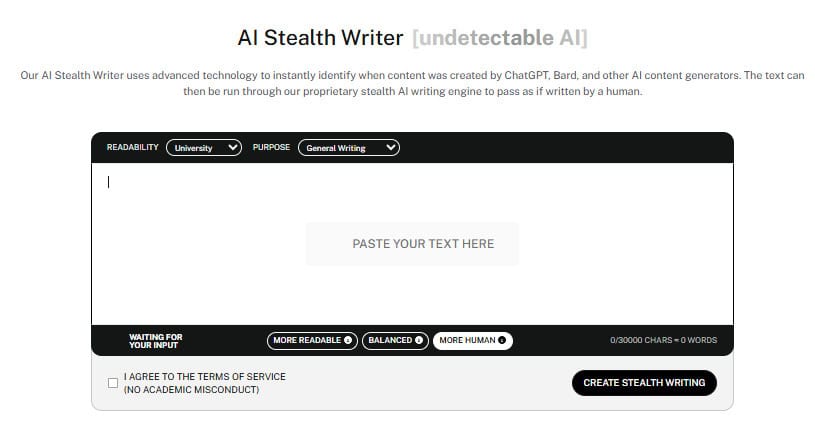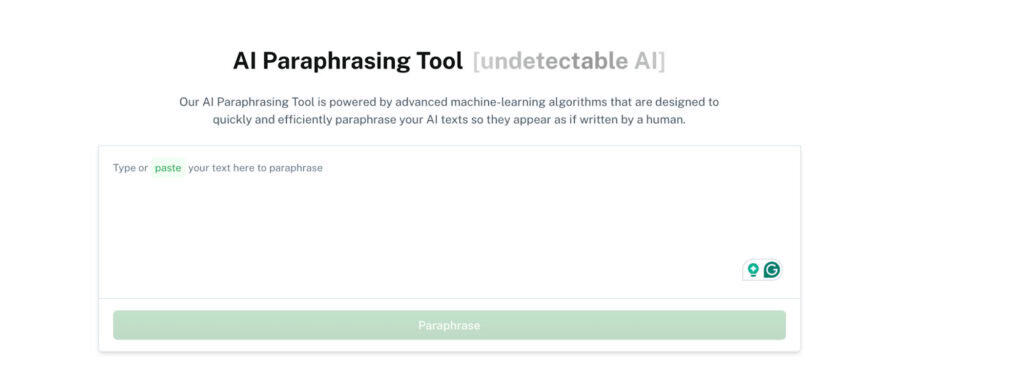With AI-generated content becoming the norm in every field these days, the need for dependable AI detection has never been greater.
Educators, content creators, recruiters, and businesses seek to reliably differentiate between human and machine-generated writing. This is where GPTZero comes in.
Whether you are grading essays, verifying online articles, or just checking your work against accidental flagging by some AI detector, you need to know how AI detectors work.
Every tech product is unique, and so are AI detectors.
Because most people ignore this fact, many users become frustrated as they use them.
In this article, we’ll explore how GPTZero works, its pros and cons, and tips on how to bypass GPTZero when necessary.
Let’s get started.
What Is GPTZero?
GPTZero is an AI detection tool made by Edward Tian, a Princeton University student, when large language models like ChatGPT were just becoming popular.
The aim of the product was to tell the difference between human content and AI-written content, so it quickly became popular among teachers and workers who were worried about people using AI for writing tasks and online content.
At the heart of it, GPTZero uses machine learning models based on a huge sample of text, both written by humans and AIs.


Never Worry About AI Detecting Your Texts Again. Undetectable AI Can Help You:
- Make your AI assisted writing appear human-like.
- Bypass all major AI detection tools with just one click.
- Use AI safely and confidently in school and work.
At first, it measured two important linguistic perceptions (perplexity and burstiness) to find out if a piece of content was likely made by a person or an AI model.
Low perplexity with low burstiness usually meant an AI wrote the text, while higher scores implied human writing.
Now, GPTZero has transformed from its earlier, more technical manifestations into a user-friendly tool that gives simple percentage readouts, showing how likely a text is to be AI-produced.
It comes as a web interface, Chrome extension, Microsoft Word add-on, and API integration, all aimed at providing flexible solutions across many platforms.
Although it is easy to use and quick to deliver results, GPTZero accuracy has sparked a debate about its reliability.
How GPTZero Works

Many users of the platform wonder, How does GPTZero work?
It starts with two main concepts: perplexity and burstiness.
These two metrics form the backbone of GPTZero’s detection logic, helping it distinguish between human writing and AI-generated text.
- Perplexity: This measures how predictable a piece of text is. AI models tend to produce highly predictable content, making perplexity scores low. Human writing, on the other hand, is often more unpredictable, resulting in higher perplexity scores.
- Burstiness: It is the variation between sentences. Humans tend to write more variably, where some sentences are short and simple, while others are long and complex. The AI-generated text, however, lacks this natural flow, and consequently, the content feels too uniform.
Initially, GPTZero heavily emphasized these scores, displaying them to users as part of its detailed analysis.
However, many found these technical metrics confusing, especially for quick classroom or workplace evaluations.
As a result, GPTZero evolved its interface to simplify the process.
Today, users get a percentage readout that shows how likely a text is human-written or AI-generated. This shift makes the tool much more accessible, particularly for non-technical users.
Behind the scenes, GPTZero uses machine learning models trained on massive datasets consisting of both AI and human text.
By analyzing patterns, predictability, and sentence structure, it attempts to make an educated guess about the text’s origin.
Additionally, GPTZero isn’t just confined to the web platform.
It also offers a Chrome extension for scanning online content, a Microsoft Word add-on for in-document analysis and an API for developers wanting to integrate AI detection into their own platforms.
GPTZero’s API has also enabled developers to build custom solutions tailored to specific industry needs, such as content verification tools for publishers or authenticity checks for recruitment platforms.
This adaptability has broadened GPTZero’s applicability across various sectors
Is GPTZero Accurate?
In terms of AI detection, the most common question is this: Is GPTZero accurate? The answer, based on extensive testing and user feedback, is a bit of a mixed bag.
According to GPTZero’s claims, it correctly identifies human-generated content 99% of the time and AI-generated content 85% of the time. These numbers look great on paper, but real-world experiences reveal some differences.
Although GPTZero is very good at identifying much AI-written material, it sometimes struggles with newer, more sophisticated AI work.
Sometimes even material that is written by a human and nothing else is wrongly identified as AI; a frustrating experience for students, professionals, and content creators alike.
It is also important to note that GPTZero’s accuracy varies based on the complexity and length of the text.
Shorter text or text with extremely technical terms may yield less accurate results, highlighting the importance of context in AI detection
In our independent tests, we fed GPTZero a sample essay generated by ChatGPT and fed our Undetectable AI humanizer the same text.
The results, as seen below, showed that while GPTZero made the right call, it wasn’t foolproof. GPTZero claimed that the text submitted was 85% AI-generated and 16% human-written.
Undetectable’s AI Detector, on the other hand, claimed that the text was 1% human-written and 99% AI-generated.
- GPTZero:

- Undetectable’s AI Detector:

Because of GPTZero’s limitations, we recommend using it in combination with Undetectable’s AI Detector to achieve the most reliable results.
Our suite of tools is designed precisely for this:
- AI Humanizer: Rewrites text with a natural rhythm and tone that feels unmistakably human.
- Stealth Writer: Generates original-sounding, human-like outputs, making detection much harder.
- AI Paraphraser: Restructures AI-written content in ways that bypass basic detection models.
After humanizing or paraphrasing your content, it’s best to double-check your work using an advanced detection tool like Undetectable AI Detector.
This layered approach dramatically boosts your chances of flying under the radar.
GPTZero is reasonably good, but it’s not perfect. For critical applications where detection could have serious consequences, relying on GPTZero alone isn’t enough.
Combining humanizing strategies with smart detection tools offers the best insurance against misclassification.
Pros and Cons of GPTZero
Like any AI detection tool, GPTZero comes with its strengths and weaknesses.
Understanding these can help you decide whether it’s the right fit or if you should be looking elsewhere.
Pros of GPTZero
- Budget Friendly: Compared to high-end options like Winston AI, GPTZero is more affordable, especially for regular users.
- Helpful Reporting Features: The Human Writing Report feature provides extra assurance that an article is written by a human being, and this is such a great help for students facing scrutiny.
- Free to Start: You can try GPTZero without signing up or paying anything, making it ideal for occasional users.
- Multiple Integrations: Works with Chrome, Word, and through API, making it flexible for many workflows.
- Simple Scoring System: Clear percentage outputs remove the guesswork and make results easier to understand.
- Educational Support: It has been adopted by various educational institutions to uphold academic integrity, offering educators a tool to detect potential AI-generated assignments
Cons of GPTZero
- Less Precise: It doesn’t consistently keep up with the latest writing technologies and can misclassify both real and generated content.
- Customer Service Issues: Some users report slow or ineffective support for billing and technical help.
- No Credit Rollover: Monthly credits expire if unused, which could waste money for light users.
- Behind the Curve: GPTZero hasn’t kept pace with newer, more advanced content generation tools and may underperform against them.
While GPTZero serves its purpose in everyday use, high-stakes users should combine it with editing tools and a stronger secondary checker for better results.
How to Bypass GPTZero
You might wonder how to bypass GPTZero without triggering its detection alarms if you’re creating content with the help of AI.
While GPTZero is fairly strong at spotting predictable, pattern-heavy AI outputs, there are proven strategies that can make your content indistinguishable from human writing.
The key lies in making your AI-generated text sound naturally human, full of irregularities, variations, and authentic tones that machines typically struggle to replicate.
Here’s how to do it effectively:
AI Humanizer
Our AI Humanizer tool rewrites AI-generated content with natural rhythm and authentic tone.
It carefully adjusts sentence structure, vocabulary choice, and phrasing to mimic real human writing patterns, making it much harder for detectors like GPTZero to flag your work.

Stealth Writer
Stealth Writer doesn’t just reword your text, it regenerates the ideas into original-sounding, human-like output.
Instead of simple paraphrasing, it recreates the flow of human thought, ensuring your content feels fresh and organic without any mechanical hints typical of AI writing.

Paraphrasing tool
Sometimes, simple rewording isn’t enough. That’s why our Paraphrasing tool goes deeper: it restructures AI-generated content in genuinely unique ways.
This includes changing paragraph structures, varying sentence lengths, and incorporating nuanced language patterns that AI detection tools often miss.

After humanizing or paraphrasing your content, don’t leave things to chance.
Run your final draft through the Undetectable AI Detector.
This extra step ensures your content is polished and safely flies under the radar of GPTZero and other similar tools.
By layering these techniques, you’re not just tweaking AI output, you’re completely reshaping it to beat even the sharpest detectors.
Bypassing GPTZero is possible, but it takes smart tools and a thoughtful process.
Explore our AI Detector and Humanizer effortlessly in the widget below!
The Mechanics Behind “Humanizing” AI Content
To successfully bypass AI detectors like GPTZero, it’s essential to understand what it truly means to “humanize” AI-generated text.
Human writing carries certain characteristics that machine outputs often miss, like randomness, emotional subtlety, imperfect sentence patterns, and creative flow.
Humanizing isn’t just about swapping a few words; it’s about reconstructing the text so that it mirrors the natural unpredictability and variation that define authentic human communication.
When AI writes, it tends to produce content that is too uniform, with consistent sentence lengths, predictable vocabulary, and even rhythmic structures that feel mechanical upon closer inspection.
The language markers that GPTZero works with target mechanical sameness.
Thus, in order to not be detected, enough variation, emotional nuance, and unpredictability must be introduced in the text.
That’s where the right tools come into play. To humanize AI content reliably and at scale, we recommend the following:
That’s where using the right tools becomes critical.
To humanize AI content reliably and at scale, we recommend the following:
- AI Humanizer: This tool fine-tunes AI-generated drafts by adjusting sentence structures, inserting natural pauses, varying word choice, and recreating a real human flow. It focuses heavily on preserving meaning while adding human-like imperfections that feel authentic.
- Stealth Writer: Instead of merely editing existing text, Stealth Writer regenerates the ideas behind the original content in a fresh, human-centric manner. It makes sure the rewritten piece reads as if someone thought it up from scratch, offering new sentence flows, emotional nuances, and creative phrasing.
- AI Paraphraser: For deeper restructuring, this tool reshapes paragraphs, diversifies sentence patterns, and reimagines the logical flow to make the text indistinguishable from human writing without changing the core ideas.
Always do a last check with the Undetectable AI Detector after writing or generating human-like text to be sure your writing gets through AI detection safely.
It’s an important final step that helps catch any leftover styles that tools like GPTZero might still flag.
Also preview your final result by reading it aloud or asking someone to review it. Human readers can often detect subtle awkwardness that machines miss
Understanding the mechanics behind humanizing isn’t just theory, it’s a vital step if you want your AI-assisted content to remain undetectable and natural.
Final Verdict: Is GPTZero Worth Using?
GPTZero is useful if you’re looking for a basic checker that’s fast and easy to use. It gives clear feedback and works across multiple platforms.
But on its own, it isn’t enough, especially if you’re working with newer-generation writing software.
For better security, use a combo of editing tools (like Rhythm Rewriter, Stealth Writer, and Text Rebuilder) followed by a scan with Undetectable.
That’s the best way to ensure your work reads naturally and avoids false flags.
In short, GPTZero is a decent first step, but not the full solution.
